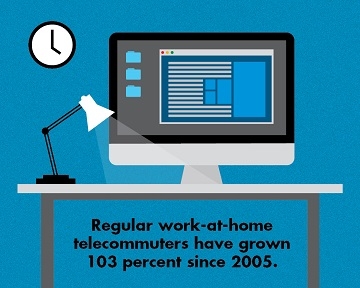- Home
- Loss Control
- Loss Control Insights
- Tips for Safer Telecommuting Habits from a Telecommuter
EMC Risk Improvement Consultant Laurie Hoskins is among the 3.7 million employees who frequently work from home. According to a recent Gallup study, regular telecommuting has grown 103% since 2005. That represents a loss control challenge for employers who are responsible for the safety of employees regardless of where they work. “Basically, employers need to train their off-site employees to be their own risk manager,” comments Hoskins, who shares her experience as both a telecommuter and a loss control professional.
Be an Equal Ergonomic Employer
You won’t find Hoskins sitting in a couch or easy chair with a computer in her lap. Technology has not only made telecommuting possible, but also a hazardous job. “With the amount of time the average worker spends using the computer, cases of cumulative trauma disorders (CTD) are on the rise,” warns Hoskins. To reduce these types of injuries, employers need to invest in training to make employees more aware of ergonomic guidelines. These tips are a good starting point.
- Office chairs should allow for the following adjustments: chair height, seat back angle and height, seat pan depth and armrests. The following adjustments should be considered: operator’s feet are firmly on the floor when sitting back in chair; 90°–110° angle in knees, hips and elbows; there should be a few inches of space between edge of seat and knees; lumbar support should fit into the small of the worker’s back; arms should be relaxed and forearms parallel with floor. If the work surface is too high, raise the chair, lower the workstation or add a footrest.
- An external keyboard and mouse should be used when working with a laptop or tablet.
- Keyboard trays and monitor risers should be used as needed, so fingers are relaxed, wrists are straight and the top of the monitor is at eye level.
- Monitors should be at least an arm’s length away.
- Lighting should be arranged to reduce reflections or glare from computer monitors.
- Train employees to improvise when on the road. For example, Hoskins recommends using an ironing board as a work surface in a hotel room because it can be easily adjusted to the proper height for the keyboard, mouse or monitor.
Going Beyond Chairs, Desks and Good Posture
Desks and chairs that facilitate good posture and reduce repetitive muscle strain are only part of the challenge telecommuters face. The Federal Emergency Management Agency shares the following safe and healthy telecommuting tips with its employees:
- Fidgeting is actually beneficial. Mayo Clinic researchers in 2005 concluded the more you move—even tapping your feet under a desk—the less likely it is that you will gain weight. Small movements have major lifestyle impacts.
- Take frequent breaks. Stand up and stretch to keep blood moving to all your limbs.
- When participating on conference calls or taking phone calls, pace around the house.
- When telecommuting, use the time saved from commuting to exercise. Whether it’s a brisk walk around the neighborhood, a run or going to the gym, a little exercise has physical and psychological benefits during the workday.
- Computer cords and telephone chargers can become a tangled mess and cause trip hazards. Avoid this risk by ensuring there is no path between your workstation and your outlet.
- Home office smoke alarms and carbon monoxide detectors should be installed and checked on a regular basis.
- Telecommuters should have clear access to a functioning fire extinguisher and a well-stocked first aid kit.
- Telecommuters should take the time to have a written emergency plan that includes emergency contact numbers posted near the phone and periodic contact time scheduled with coworkers.
The Good News and Bad News About Telecommuting
The advantages associated with telecommuting are too great to ignore. Employees have greater flexibility and higher job satisfaction while employers improve retention, reduce absenteeism, improve their recruiting efforts and save on office space requirements. But accidents and injuries that can reduce productivity and increase insurance costs can happen in any work environment. “Remember, you’re responsible for the safety of workers wherever they work,” concludes Hoskins.
Get in touch
Need help? We’re here for you! Whether you have questions or need personalized assistance, your local office is ready to support you.
Loss Control Insights
Stay informed with the latest news and receive actionable safety tips, all carefully curated by our team of experts.
